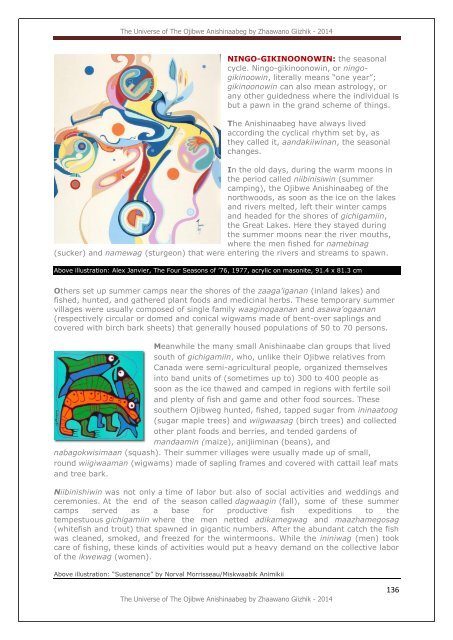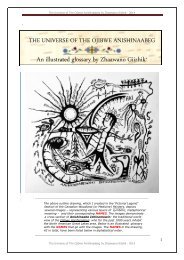The Universe Of The Ojibwe Anishinaabeg, an illustrated glossary by Zhaawano Giizhik*
A Glossary written and illustrated by Native Woodland artist Zhaawano Giizhik demonstrating a cross section of Anishinaabe Izhinamowin: the traditional worldview of the Ojibwe Anishinaabeg, who for the past 2 millennia inhabit the North American Great Lakes area.
A Glossary written and illustrated by Native Woodland artist Zhaawano Giizhik demonstrating a cross section of Anishinaabe Izhinamowin: the traditional worldview of the Ojibwe Anishinaabeg, who for the past 2 millennia inhabit the North American Great Lakes area.
You also want an ePaper? Increase the reach of your titles
YUMPU automatically turns print PDFs into web optimized ePapers that Google loves.
<strong>The</strong> <strong>Universe</strong> of <strong>The</strong> <strong>Ojibwe</strong> <strong>Anishinaabeg</strong> <strong>by</strong> Zhaaw<strong>an</strong>o Giizhik - 2014<br />
NINGO-GIKINOONOWIN: the seasonal<br />
cycle. Ningo-gikinoonowin, or ningogikinoowin,<br />
literally me<strong>an</strong>s “one year”;<br />
gikinoonowin c<strong>an</strong> also me<strong>an</strong> astrology, or<br />
<strong>an</strong>y other guidedness where the individual is<br />
but a pawn in the gr<strong>an</strong>d scheme of things.<br />
<strong>The</strong> <strong>Anishinaabeg</strong> have always lived<br />
according the cyclical rhythm set <strong>by</strong>, as<br />
they called it, a<strong>an</strong>dakiiwin<strong>an</strong>, the seasonal<br />
ch<strong>an</strong>ges.<br />
In the old days, during the warm moons in<br />
the period called niibinisiwin (summer<br />
camping), the <strong>Ojibwe</strong> <strong>Anishinaabeg</strong> of the<br />
northwoods, as soon as the ice on the lakes<br />
<strong>an</strong>d rivers melted, left their winter camps<br />
<strong>an</strong>d headed for the shores of gichigamiin,<br />
the Great Lakes. Here they stayed during<br />
the summer moons near the river mouths,<br />
where the men fished for namebinag<br />
(sucker) <strong>an</strong>d namewag (sturgeon) that were entering the rivers <strong>an</strong>d streams to spawn.<br />
Above illustration: Alex J<strong>an</strong>vier, <strong>The</strong> Four Seasons of ’76, 1977, acrylic on masonite, 91.4 x 81.3 cm<br />
Others set up summer camps near the shores of the zaaga’ig<strong>an</strong><strong>an</strong> (inl<strong>an</strong>d lakes) <strong>an</strong>d<br />
fished, hunted, <strong>an</strong>d gathered pl<strong>an</strong>t foods <strong>an</strong>d medicinal herbs. <strong>The</strong>se temporary summer<br />
villages were usually composed of single family waaginoga<strong>an</strong><strong>an</strong> <strong>an</strong>d asawa’oga<strong>an</strong><strong>an</strong><br />
(respectively circular or domed <strong>an</strong>d conical wigwams made of bent-over saplings <strong>an</strong>d<br />
covered with birch bark sheets) that generally housed populations of 50 to 70 persons.<br />
Me<strong>an</strong>while the m<strong>an</strong>y small Anishinaabe cl<strong>an</strong> groups that lived<br />
south of gichigamiin, who, unlike their <strong>Ojibwe</strong> relatives from<br />
C<strong>an</strong>ada were semi-agricultural people, org<strong>an</strong>ized themselves<br />
into b<strong>an</strong>d units of (sometimes up to) 300 to 400 people as<br />
soon as the ice thawed <strong>an</strong>d camped in regions with fertile soil<br />
<strong>an</strong>d plenty of fish <strong>an</strong>d game <strong>an</strong>d other food sources. <strong>The</strong>se<br />
southern <strong>Ojibwe</strong>g hunted, fished, tapped sugar from ininaatoog<br />
(sugar maple trees) <strong>an</strong>d wiigwaasag (birch trees) <strong>an</strong>d collected<br />
other pl<strong>an</strong>t foods <strong>an</strong>d berries, <strong>an</strong>d tended gardens of<br />
m<strong>an</strong>daamin (maize), <strong>an</strong>ijiimin<strong>an</strong> (be<strong>an</strong>s), <strong>an</strong>d<br />
nabagokwisima<strong>an</strong> (squash). <strong>The</strong>ir summer villages were usually made up of small,<br />
round wiigiwaam<strong>an</strong> (wigwams) made of sapling frames <strong>an</strong>d covered with cattail leaf mats<br />
<strong>an</strong>d tree bark.<br />
Niibinishiwin was not only a time of labor but also of social activities <strong>an</strong>d weddings <strong>an</strong>d<br />
ceremonies. At the end of the season called dagwaagin (fall), some of these summer<br />
camps served as a base for productive fish expeditions to the<br />
tempestuous gichigamiin where the men netted adikamegwag <strong>an</strong>d maazhamegosag<br />
(whitefish <strong>an</strong>d trout) that spawned in gig<strong>an</strong>tic numbers. After the abund<strong>an</strong>t catch the fish<br />
was cle<strong>an</strong>ed, smoked, <strong>an</strong>d freezed for the wintermoons. While the ininiwag (men) took<br />
care of fishing, these kinds of activities would put a heavy dem<strong>an</strong>d on the collective labor<br />
of the ikwewag (women).<br />
Above illustration: “Susten<strong>an</strong>ce” <strong>by</strong> Norval Morrisseau/Miskwaabik Animikii<br />
<strong>The</strong> <strong>Universe</strong> of <strong>The</strong> <strong>Ojibwe</strong> <strong>Anishinaabeg</strong> <strong>by</strong> Zhaaw<strong>an</strong>o Giizhik - 2014<br />
136





